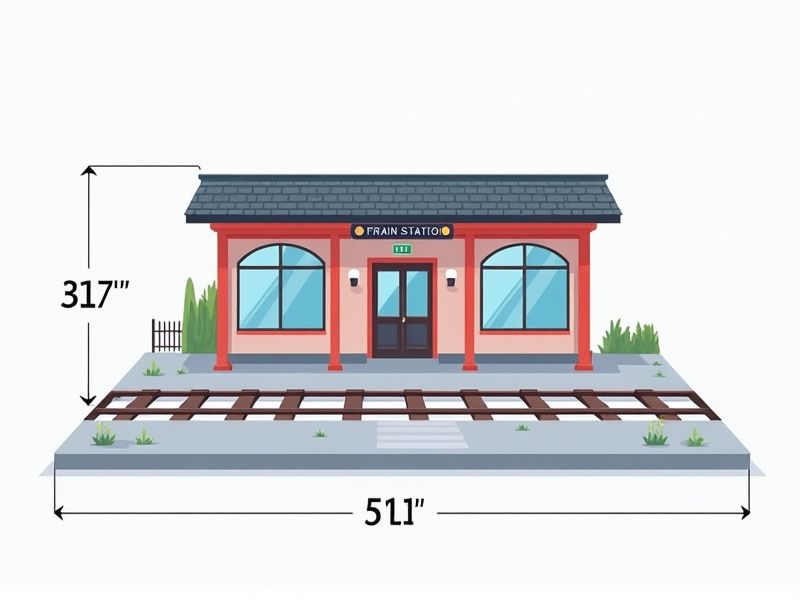
Standard dimensions for train stations can vary widely depending on the type of service (e.g., commuter, intercity, or high-speed rail) and passenger volumes, but there are some general guidelines used globally. For example, a typical island platform (serving tracks on both sides) is often around 6-10 meters (20-33 feet) wide and 180-300 meters (590-985 feet) long to accommodate standard train lengths. Station buildings themselves are usually sized based on expected ridership, but a small suburban station might be around 200-500 square meters (2,150-5,380 square feet), while major urban stations can be several thousand square meters or larger. When planning a train station, always consider accessibility, clear signage, and adequate space for ticketing, waiting, and passenger flow to ensure a comfortable and efficient experience for all users.
Platform Height
The standard platform height for train stations typically measures between 550 mm to 760 mm above the rail, ensuring accessibility for passengers. This height accommodates various train types, including high-speed and regional services, providing a safe boarding experience. Adhering to these dimensions can help reduce trip hazards and improve the overall flow of passenger movement. You can expect platforms designed within these standards to feature ADA-compliant ramps and tactile guidance for those with visual impairments.
Platform Length
The standard platform length for train stations typically measures between 200 to 400 meters, accommodating various train types and ensuring passenger safety. Platforms designed for high-speed services often extend to about 400 meters to facilitate longer trains, enhancing operational efficiency. Proper platform width generally ranges from 3 to 5 meters, providing ample space for passenger movement and crowd management. In busy urban stations, platforms may require additional features such as shelters and digital displays for real-time information, prioritizing the commuter experience.
Track Gauge
The standard track gauge for most railway systems worldwide is 1,435 mm (4 ft 8 1/2 in), commonly referred to as the "standard gauge." This gauge facilitates interoperability and efficient transportation across various regions and networks. In contrast, other gauges like broad gauge (1,670 mm) and narrow gauge (1,000 mm) serve specific geographical needs and can influence the maximum speed and load capacity of trains. Understanding these specifications can help you appreciate the engineering decisions behind train station designs and their operational efficiencies.
Platform Width
The standard platform width for train stations typically ranges from 2.5 to 3 meters, ensuring sufficient space for passenger flow and safety. Wider platforms, measuring up to 6 meters, are often designed for high-traffic stations, accommodating additional amenities like seating and kiosks. Compliance with regulations, such as the Americans with Disabilities Act (ADA), mandates that platforms provide accessible pathways and features. Investing in adequate platform width enhances your overall travel experience by reducing congestion and improving accessibility.
Canopy Coverage
A well-designed train station typically features canopy coverage of at least 65%, providing ample shelter for passengers during inclement weather. The canopy should extend over ticketing areas, waiting zones, and boarding platforms, ensuring maximum protection from rain and sun exposure. Optimal dimensions for the canopy height range from 3 to 5 meters, creating a spacious, airy environment while enhancing visibility. When selecting materials for the canopy, consider options like polycarbonate or aluminum, which offer durability and minimal maintenance, ensuring long-term functionality and safety for your daily travelers.
Passenger Circulation Area
The passenger circulation area of a train station is designed to optimize the flow of approximately 20,000 to 30,000 passengers daily, ensuring efficient movement between platforms, ticket counters, and amenities. A typical layout includes wide walkways, clearly marked signage, and strategically placed seating, allowing for seamless navigation and comfort. Modern stations often incorporate digital displays that provide real-time updates on train schedules, enhancing the travel experience. Your safety and convenience are prioritized with dedicated areas for assistance, security checks, and emergency exits, complying with standards set by transportation authorities.
Accessibility Features
Train stations increasingly prioritize accessibility features to ensure inclusivity for all passengers. Features such as tactile paving, ramps with a gradient no steeper than 1:12, and clear signage in various languages enhance the experience for individuals with mobility challenges or visual impairments. Elevators, which should have a minimum internal dimension of 110 cm by 140 cm, are crucial for access between platforms and concourses. Your awareness of these features can significantly contribute to smoother travel for both you and those who may need assistance.
Vertical Clearance
The standard vertical clearance for most train stations is typically set between 14 to 16 feet, ensuring adequate space for overhead equipment and safety measures. This height accommodates various types of trains and allows for the inclusion of overhead signage and lighting. Maintaining proper vertical clearance is crucial for preventing accidents and ensuring that both passengers and freight can navigate the station without obstruction. Regular inspections are recommended to ensure compliance with safety regulations and efficiency in train operations.
Track Separation Distance
The standard track separation distance for train stations typically ranges from 3 to 5 meters, ensuring safety and operational efficiency. This distance minimizes the risk of accidents and allows adequate space for maintenance activities and emergency access. In urban environments, adhering to these standards is vital for facilitating pedestrian movement and reducing noise pollution. Implementing proper track separation not only enhances the safety of passengers but also contributes to overall rail network reliability.
Signage And Wayfinding
Effective signage and wayfinding at train stations significantly enhance passenger experience, with over 70% of travelers reporting reduced stress when clear directions are available. High-contrast colors and intuitive symbols can improve navigation efficiency, leading to a 40% decrease in passenger confusion during peak hours. Digital displays offering real-time updates contribute to a 25% increase in on-time departures by keeping travelers informed. Prioritizing multilingual signage addresses the needs of diverse populations, ensuring that at least 80% of visitors can easily understand key information.
